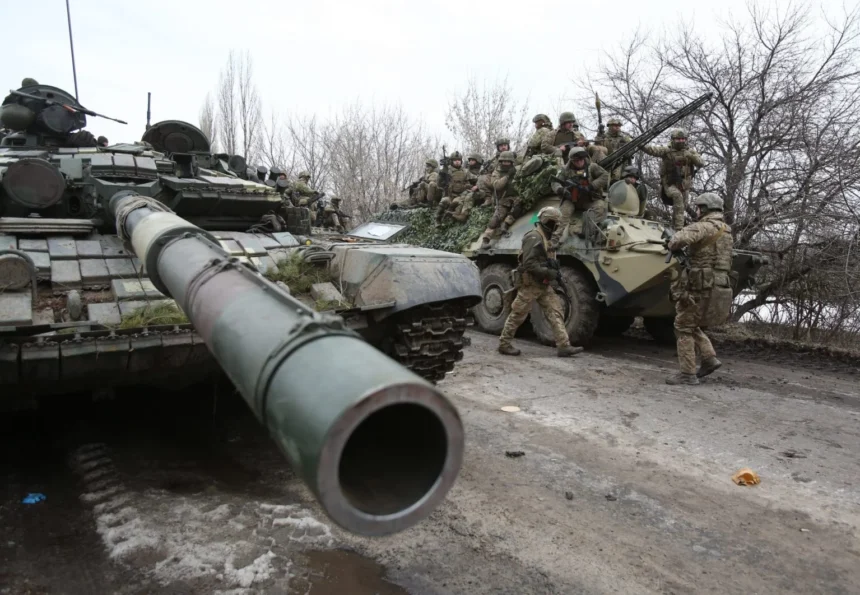Russia Advances in Donetsk Region, Capturing Key Settlements Amid Intensified Fighting
On Saturday, Russia’s Defence Ministry announced that its forces had successfully captured two more settlements in the eastern Ukrainian region of Donetsk. This latest advancement is part of a continued push by Russian troops to expand their control in the area, following a series of steady territorial gains in the Donbas region. The Russian Ministry of Defence stated that Petropavlivka, a small village situated between the towns of Pokrovsk and Kurakhove, had fallen into their hands, marking a significant gain in an area that has been a focal point of recent fighting. Additionally, Russian forces reported the capture of Vremivka, a town further south in the Donetsk region, reinforcing their strategic position in the area.
These territorial gains are seen as part of Russia’s ongoing military strategy to fully capture the Donbas region, which includes both Donetsk and Luhansk. The region has been central to the conflict between Russia and Ukraine since the invasion began in February 2022. While Russian forces now control roughly 20% of Ukraine’s territory, their focus remains on securing the entirety of Donetsk and Luhansk.
Tensions Escalate as Russia Responds to Ukrainian Strikes
The Russian Ministry’s statement also highlighted their retaliation to an attack launched by Ukraine on Russia’s Belgorod region, which borders Ukraine’s Kharkiv region. According to the ministry, Ukrainian forces used U.S.-made ATACMS missiles to strike military targets in the southern Belgorod region. In response, Russia claimed to have struck Ukrainian military facilities with high-precision weapons. The military exchange underscores the growing tensions and escalation of the conflict, as both sides continue to target critical infrastructure in an attempt to weaken the other’s military capabilities.
The situation in the Belgorod region remains tense, and these missile strikes reflect the broader escalation in the war. Ukrainian forces have been employing longer-range weaponry, including the ATACMS, which has allowed them to target deeper into Russian-held territory. This new phase of attacks represents an increase in Ukraine’s offensive capabilities, challenging Russian forces even as they continue their territorial advances in the Donbas region.
Ukraine Denies Loss of Pokrovsk, Describes Heavy Fighting
On the Ukrainian side, military officials have not confirmed Russia’s claims regarding the capture of Petropavlivka or Vremivka. While they acknowledged heavy fighting in the Pokrovsk sector, they specifically denied that Russian forces had entered the city of Pokrovsk, a critical transport hub in the Donetsk region. The spokesperson for the Ukrainian military’s Khortytsya group, Viktor Trehubov, reiterated on national television that “there have been no developments in Pokrovsk, things are stable.” He added, “The enemy is not there,” signaling Ukraine’s determination to hold on to this vital strategic location.
Pokrovsk, known for being an essential transport hub and a site of Ukraine’s only active coking coal pit, has been a target of intense Russian attacks in recent months. Despite the ongoing assaults, Ukraine’s military maintains control over the city. However, this week, operations at the coking coal pit were suspended, a significant blow to Ukraine’s industrial capabilities in the region. The city’s strategic importance, combined with its proximity to other contested areas, has made it a key target for Russian forces seeking to disrupt Ukrainian supply lines.
Ongoing Battles and Russian Attempts to Break Ukrainian Defenses
Meanwhile, Ukrainian military reports indicate that Russia has launched 84 attacks in the Pokrovsk sector alone, with 14 battles still ongoing in the area. These figures reflect the intensity of the clashes as Russian forces continue to press on with their offensive. The Ukrainian General Staff’s late-night report listed several villages in the Pokrovsk sector that have come under Russian attack. Among them are three villages that Russia claimed to have secured in the past week, as well as another settlement that fell to Russian forces in the previous month.
The situation in the Pokrovsk sector remains fluid, with Ukrainian forces working tirelessly to defend their positions against Russian advances. The ongoing battles are a testament to the resilience of Ukrainian troops, who have managed to stave off Russian forces in some areas despite being under constant pressure. The report from the Ukrainian military also highlights the difficulty of repelling Russian attacks, as Moscow’s forces attempt to breach Ukrainian defenses in a concentrated push for further territorial gains.
The Larger Context: Russia’s Shift in Focus Toward Donbas
Since the initial failure of its attempts to capture Kyiv early in the war, Russia has shifted its military focus primarily to the Donbas region, which includes the Donetsk and Luhansk areas. Both regions have been the epicenter of the conflict, with separatist forces, supported by Russia, having controlled parts of Donetsk and Luhansk since 2014. After Russia’s invasion of Ukraine, the Donbas became a central battleground for the war.
The capture of Donetsk and Luhansk has long been one of Russia’s primary objectives, and the recent territorial gains in Petropavlivka and Vremivka represent incremental steps toward that goal. Russia has consistently sought to control the entire Donbas region, not only for its strategic significance but also for its valuable industrial resources. The region is home to significant coal deposits and has been a major industrial center for Ukraine. By capturing these areas, Russia aims to solidify its territorial control and disrupt Ukraine’s industrial capacity.
Ukraine, on the other hand, is determined to retain control over the Donbas, viewing its defense of the region as critical to the country’s sovereignty and territorial integrity. The fighting in Donetsk and Luhansk is expected to continue to intensify as both sides fight for control of key cities and strategic positions.
The Human Cost of the Conflict
The conflict in eastern Ukraine has taken a devastating toll on both the civilian population and military personnel. The capture of settlements like Petropavlivka and Vremivka, while strategically significant, also comes at a heavy cost in terms of human lives and displacement. Reports from both sides indicate that civilians in the region are facing increasingly difficult living conditions, with many forced to flee their homes to escape the fighting. The humanitarian impact of the conflict continues to grow as more areas are affected by the violence.
Additionally, the ongoing attacks on military targets, including airstrikes and missile strikes, have left large portions of the region’s infrastructure in ruins. The destruction of roads, bridges, and industrial facilities has further complicated efforts to deliver aid to those in need. Despite these challenges, humanitarian organizations continue to provide assistance to those affected by the conflict, although access to some areas remains limited due to the ongoing hostilities.
Conclusion: A Stalemate With No End in Sight
As the conflict in eastern Ukraine continues, the situation remains highly volatile, with both Russian and Ukrainian forces locked in a tense and bloody standoff. While Russia has made significant territorial gains in recent months, its forces continue to face stiff resistance from Ukrainian troops who are determined to defend their homeland.
The ongoing battles in Donetsk, including the fierce fighting near Pokrovsk, highlight the challenges both sides face as they vie for control of the region. Despite Russia’s advancements, Ukraine has proven resilient, pushing back Russian forces in several areas and defending key cities from further encroachment.
With no clear end to the conflict in sight, the human cost continues to mount. The war has become a battle of attrition, with each side trying to gain the upper hand in a conflict that shows little sign of abating. The outcome of the struggle for Donetsk and the Donbas region will likely play a crucial role in shaping the future of the war and the broader geopolitical landscape in Eastern Europe.




